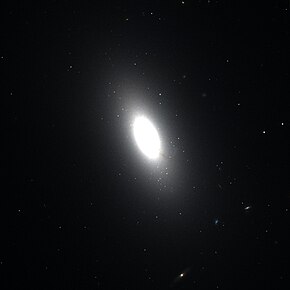NGC 3377
Appearance
| NGC 3377 | |
|---|---|
 Hubble Space Telescope image of NGC 3377 | |
| Observation data (J2000 epoch) | |
| Constellation | Leo |
| Right ascension | 10h 47m 42.4s |
| Declination | +13° 59′ 08″ |
| Redshift | 0.002218 ± 0.000008 [1] |
| Distance | 11.2[2] Mpc |
| Apparent magnitude (V) | 10.2[3] |
| Characteristics | |
| Type | E5[1] |
| Apparent size (V) | 5′.2 × 3′.0[4] |
| Other designations | |
| UGC 5899, PGC 32249[1] | |
NGC 3377 is an elliptical galaxy in the constellation Leo. It is a member of the M96 Group and is about 26 Mly away, with a diameter of approximately 40 000 ly.[4] The supermassive black hole at the core of NGC 3377 has a mass of 8.0+0.5
−0.6×107 M☉.[2] A very faint companion galaxy, NGC 3377A is 7.1' NW.[4]
Gallery
-
SDSS image of NGC 3377
References
- ^ a b c "NASA/IPAC Extragalactic Database". Results for NGC 3377. Retrieved 2013-07-23.
- ^ a b Graham, Alister W. (November 2008), "Populating the Galaxy Velocity Dispersion - Supermassive Black Hole Mass Diagram: A Catalogue of (Mbh, σ) Values", Publications of the Astronomical Society of Australia, 25 (4): 167–175, arXiv:0807.2549, Bibcode:2008PASA...25..167G, doi:10.1071/AS08013, S2CID 89905.
- ^ Frommert, Hartmut. "NGC 3377". SEDS. Archived from the original on 6 July 2015. Retrieved 6 July 2015.
- ^ a b c Bratton, Mark (2011). The complete guide to the Herschel objects : Sir William Herschel's star clusters, nebulae, and galaxies. Cambridge University Press. p. 293. ISBN 978-0-521-76892-4.
External links
 Media related to NGC 3377 at Wikimedia Commons
Media related to NGC 3377 at Wikimedia Commons- NGC 3377 on WikiSky: DSS2, SDSS, GALEX, IRAS, Hydrogen α, X-Ray, Astrophoto, Sky Map, Articles and images

